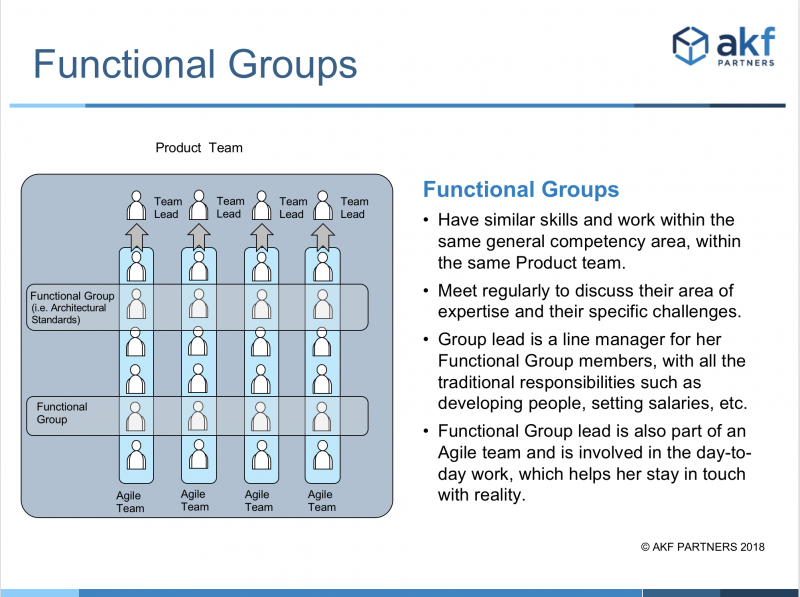
Three Reasons Your Software Engineers May Not Be Successful
At AKF Partners, we have the unique opportunity to see trends among startups and well-established companies in the dozens of technical due diligence and more in-depth technology assessments we regularly perform, in addition to filling interim leadership roles within organizations. Because we often talk with a variety of folks from the CEO, investors, business leadership, and technical talent, we get a unique top-to-bottom perspective of an organization.
Three common observations
- People mostly identify with their job title, not the service they perform.
- Software Engineers can be siloed in their own code vs. contributing to the greater outcome.
- CEO’s vision vs. frontline perception of things as they really are.
Job Titles Vs. Services
The programmer who identifies herself as “a search engineer” is likely not going to be as engaged as her counterpart who describes herself as someone who "helps improve our search platform for our customers.”
Shifting focus from a job title to a desired outcome is a best practice from top organizations. We like to describe this as separating nouns and verbs – "I am a software engineer" focuses on the noun without an action: software engineer instead of "I simplify search" where the focus is on verb of the desired outcome: simplify. It may seem minor or trivial, but this shift can be a contributing impact on how team members understand their contribution to your overall organization.
Removing this barrier to the customer puts team members on the front line of accountability to customer needs – and hopefully also the vision and purpose of the company at large. To instill a customer experience, outcome based approach often requires a reworking of product teams given our experience with successful companies. Creating a diverse product team (containing members of the Architecture, Product, QA and Service teams for example) that owns the outcomes of what they produce promotes:
- Motivation
- Quality
- Creating products customers love
If you have had experience in a Ford vehicle with the first version of Sync (bluetooth connectivity and onscreen menus) – then you are well aware of the frustration of scrolling through three layers of menus to select “bluetooth audio” ([Menu] -> [OK] -> [OK] -> [Down Arrow]-> [OK] -> [Down Arrow] -> [OK]) each time you get into your car. The novelty of wireless streaming was a key differentiator when Sync first was introduced – but is now table stakes in the auto industry – and quickly wears off when having to navigate the confusing UI likely designed by product engineers each focused on a specific task but void of designing for a great user experience. What was missing is someone with the vision and job description: "I design wireless streaming to be seamless and awesome - like a button that says "Bluetooth Audio!!!"
Hire for – and encourage – people who believe and practice “my real job is to make things simple for our customers.”
Avoiding Siloed Approach
Creating great products requires engineers to look outside of their current project specific tasks and focus on creating great customer experiences. Moving from reactively responding to customer reported problems to proactively identifying issues with service delivery in real time goes well beyond just writing software. It moves to creating solutions.
Long gone are the "fire and forget" days of writing software, burning to a CD and pushing off tech debt until the next version. To Millennials, this Waterfall approach is foreign, but unfortunately we still see this mentality engrained in many company cultures.
Today it is all about services. A release is one of many in a very long evolution of continual improvement and progression. There isn’t Facebook V1 to be followed by V2 … it is a continual rolling out of upgrades and bug fixes that are done in the background with minimum to no downtime. Engineers can't afford to be laggard in their approach to continual evolution, addressing tech debt, and contributing to internal libraries for the greater good.
Ensure your technical team understands and is very closely connected to the evolving customer experience and have skin in the game. Among your customers, there likely is very little patience with “wait until our next release.” They expect immediately resolution or they will start shopping the competition.
Translating the Vision of the CEO to the Front Lines
During our our more in-depth technology review engagements we interview many people from different layers of management and different functions within the organization. This gives us a unique opportunity to see how the vision of the CEO migrates down through layers of management to the front-line programmers who are responsible for translating the vision into reality.
Usually - although not always - the larger the company, the larger the divide between what is being promised to investors/Wall Street and what is understood as the company vision by those who are actually doing the work. Best practices at larger companies include regular all-hands where the CEO and other leaders share their vision and are held accountable to deliverables and leadership checks that the vision is conveyed in product roadmaps and daily stand up meetings. When incentive plans focus directly on how well a team and individual understand and produce products to accomplish the company vision, communication gaps close considerably.
Creating and sustaining successful teams requires a diverse mix of individuals with a service mindset. This is why we stress that Product Teams need to be all inclusive of multiple functions. Architecture, Product, Service, QA, Customer Service, Sales and others need to be included in stand up meetings and take ownership in the outcome of the product.

The Dev Team shouldn’t be the garbage disposal for what Sales has promised in the most recent contract or what other teams have ideated without giving much thought to how it will actually be implemented.
When your team understands the vision of the company - and how customers are interacting with the services of your company - they are in a much better position to implement it into reality.
As a CTO or CIO, it is your responsibility to ensure what is promised to Wall Street, private investors, and customers is translated correctly into the services you ultimately create, improve, and publish.
Conclusions
As we look at new start-ups facing explosive 100-200% year-over-year growth, our question is always “how will the current laser focus vision and culture scale?” Standardization, good Agile practices, understanding technical debt, and creating a scalable on-boarding and mentoring process all lend to best answers to this question.
When your development teams are each appropriately sized, include good representation of functional groups, each team member identifies with verbs vs. nouns ("I improve search" vs. "I’m a software engineer”), and understand how their efforts tie into company success, your opportunities for success, scalability, and adaptability are maximized.
RELATED CONTENT
Do You Know What is Negatively Affecting Your Engineers’ Productivity? Shouldn’t You?
Enabling Time to Market (TTM) With Contributor Model Teams
---
Experiencing growing or scaling pains? AKF is here to help! We are an industry expert in technology scalability, due diligence, and helping to fill leadership gaps with interim CIO/CTO and other positions in addition to helping you in your search for technical leaders. Put our 200+ years of combined experience to work for you today!